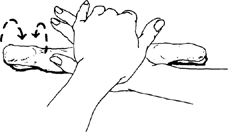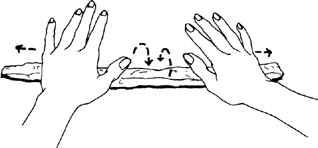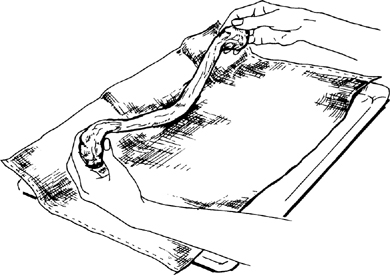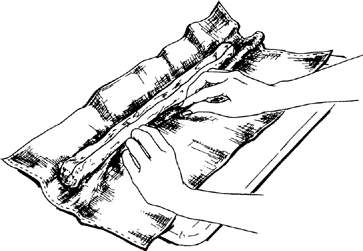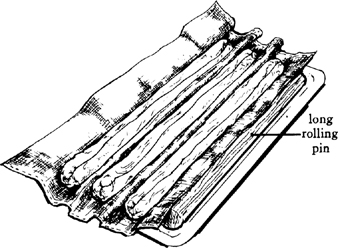Mastering the Art of French Cooking, Volume 2 (29 page)
Read Mastering the Art of French Cooking, Volume 2 Online
Authors: Julia Child

| Now, by rolling the dough back and forth with the palms of your hands, you will lengthen it into a sausage shape. |
Roll dough forward and backward rapidly, gradually sliding your hands toward the two ends as the dough lengthens. |
|
Deflate any gas blisters on the surface by pinching them. Repeat the rolling movement rapidly several times until the dough is 16 inches long, or whatever length will fit on your baking sheet. During the extension rolls, keep circumference of dough as even as possible and try to start each roll with sealed side of dough down, twisting the rope of dough to straighten the line of seal as necessary. If seal disappears, as it sometimes does with all-purpose flour, do not worry.
Place the shaped piece of dough, sealed side up, at one side of the flour-rubbed canvas, leaving a free end of canvas 3 to 4 inches wide. |
|
Pinch a ridge 2½ |
|
| After all the pieces of dough are in place, brace the two sides of the canvas with long rolling pins |
7)
Final rise—l’apprêt—1½ to 2½ hours at around 70 degrees
The covered dough is now to rise to almost triple in volume; look carefully at its pre-risen size so that you will be able to judge correctly. It will be light and swollen when risen, but will feel still a little springy when pressed.
It is important that the final rise take place where it is dry; if your kitchen is damp, hot, and steamy, let the bread rise in another room or dough will stick to canvas and you will have difficulty getting it off and onto the baking sheet. It will turn into bread in the oven whatever happens, but you will have an easier time and a better loaf if you aim for ideal conditions.
Preheat oven to 450 degrees 30 minutes before estimated baking time.
(*)
DELAYED ACTION
: See chart at end of recipe.
8)
Unmolding risen dough onto baking sheet—le démoulage
The 3 pieces of risen dough are now to be unmolded from the canvas and arranged upside down on the baking sheet. The reason for this reversal is that the present top of the dough has crusted over during its rise; the smooth, soft underside should be uppermost in the oven so that the dough can expand and allow the loaf its final puff of volume. For the unmolding you will need a non-sticking intermediate surface such as a stiff piece of cardboard or plywood sprinkled with cornmeal or pulverized pasta.
